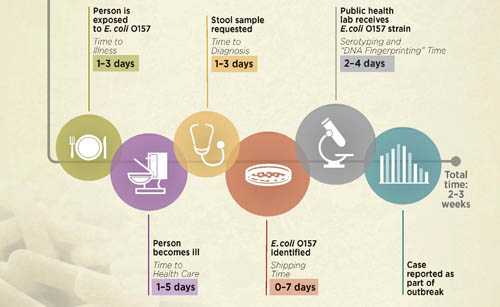Timeline for Reporting Cases of E. coli O157 Infection
To find cases in an outbreak of Escherichia coli O157 (E. coli O157) infections, public health laboratories perform a kind of “DNA fingerprinting” on E. coli O157 laboratory samples. Investigators determine whether the “DNA fingerprint” pattern of E. coli O157 bacteria from one person is the same as that from other people in the outbreak and from the contaminated food, water, or infected animal. Bacteria with the same “DNA fingerprint” are likely to come from the same source. Public health officials conduct intensive investigations, including interviews with ill people, to determine if people whose infecting bacteria match by “DNA fingerprinting” are part of a common-source outbreak.
A series of events occurs between the time a person is infected and the time public health officials can determine that the person is part of an outbreak. This means that there will be a delay between when a person gets sick and confirmation that he or she is part of an outbreak. Public health officials work hard to speed up the process as much as possible. The timeline is as follows:
- Time to illness: The time from when a person is exposed to E. coli O157 from contaminated food, water, or an infected animal or person to the beginning of symptoms. For E. coli O157, this is typically 1-3 days.
- Time to contact with health care provider: The time from the first symptom until the person seeks medical care, when a diarrhea sample is collected for laboratory testing. This is typically 1-5 days.
- Time to diagnosis: The time from when a person gives a stool sample to when E. coli O157 is obtained from it in a laboratory. This may be 1-3 days from the time the sample is received in the laboratory. The diagnosis of E. coli infection may be reported to the local health department at this time.
- E. coli isolate shipping time: The time required to ship the E. coli O157 bacteria from the laboratory to the state public health authorities that will perform “DNA fingerprinting.” This may take 0-7 days depending on transportation arrangements within a state and the distance between the clinical laboratory and public health department.
- Time to serotyping and “DNA fingerprinting”: The time required for the state public health authorities to perform “DNA fingerprinting” on the E. coli O157 isolate and compare it with the pattern of the outbreak strain. Ideally, this can be accomplished in 1 day. However, many public health laboratories have limited staff and space, and experience multiple emergencies at the same time. Thus, the process may take 2-4 days.
Did You Know? The time from the beginning of the person's illness to the confirmation that he or she was part of an outbreak is typically about 2-3 weeks. Case counts during an outbreak investigation are therefore always preliminary and must be interpreted within this context.
- Page last reviewed: December 1, 2014
- Page last updated: December 1, 2014
- Content Source:


 ShareCompartir
ShareCompartir
